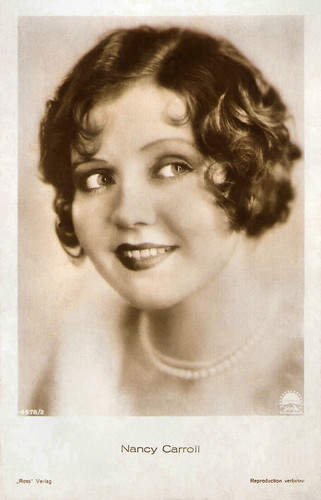
German postcard by Ross Verlag, no. 4978/2, 1929-1930. Photo: Paramount Pictures.
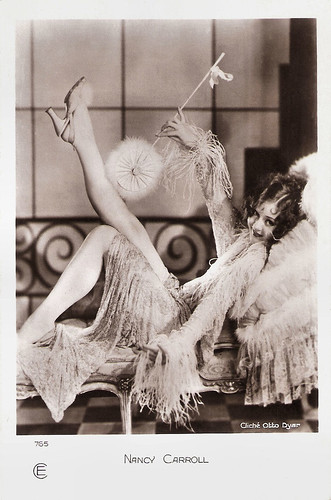
French postcard by Cinémagazine-Edition, no. 765. Photo: Otto Dyar.
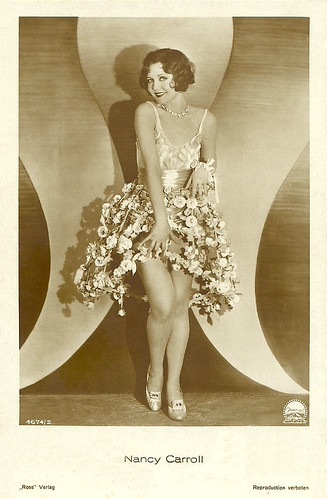
German postcard by Ross Verlag, no. 4674/2, 1929-1930. Photo: Paramount. Collection: Didier Hanson.

German postcard by Ross Verlag, no. 4681/1, 1929-1930. Photo: Paramount. Charles Rogers and Nancy Carroll in Close Harmony (John Cromwell, A. Edward Sutherland, 1929).
>
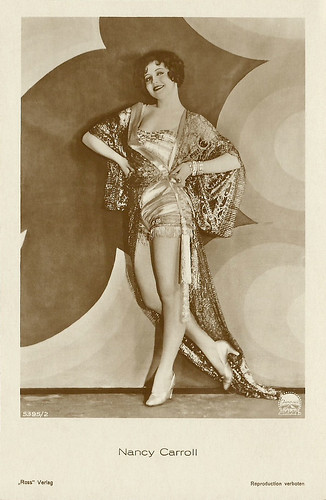
German postcard by Ross Verlag, no. 5395/2, 1930-1931. Photo: Paramount. Collection: Didier Hanson.
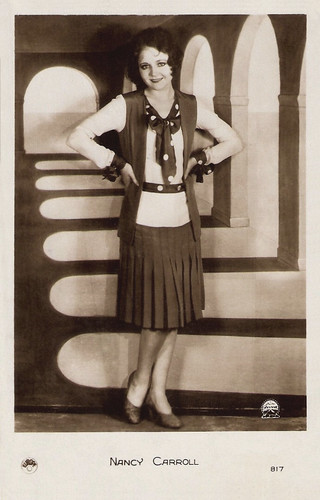
French postcard by Europe, no. 817. Photo: Paramount.
A formidable film force
Nancy Carroll was born Ann Veronica LaHiff in New York in 1903 (some sources say 1904). She was the daughter of Thomas and Ann Lahiff, of Irish parentage. Her education came at Holy Trinity School in New York, but she left there at age 16 to work as a stenographer in the office of a lace manufacturer. She was smitten early by the acting bug and she had some limited experience on New York stages.
When she was just 14, she appeared in the silent Western Riders of the Purple Sage (Frank Lloyd, 1918), starring William Farnum. The film was not a success and the girl returned to school and did accidental acting stints. But she had tasted life in front of the camera and wanted to get back there someday. Carroll and her sister Elsie performed a dancing act in a local contest of amateur talent. This led to an acting career in Broadway musicals. After being spotted in a play on the West Coast, she finally made her 'second' film debut in Ladies Must Dress (Victor Heerman, 1927) with Virginia Valli. She impressed the right people and was signed to a contract with Paramount.
In 1928 she appeared in seven films including Manhattan Cocktail (Dorothy Arzner, 1928) with Richard Arlen, and Chicken a La King (Henry Lehrman, 1928). She established her reputation as Barbara Quayle in Easy Come, Easy Go (Frank Tuttle, 1928), a vehicle for Richard Dix. It was a big hit and made Nancy Carroll a formidable film force.
Her next film was Abie's Irish Rose (Victor Fleming, 1928), adapted from the stage version that had run on Broadway for six years. Paramount shelled out $500,000 for the film rights (the highest at that time) and cast Nancy as Rosemary Murphy. She and her co-star Charles 'Buddy' Rogers made a lovely stage couple, but other films with a similar theme caused the film did not do well at the box office.
In 1929 Nancy Carroll had another big hit with her part in The Shopworn Angel (Richard Wallace, 1928) with a young Gary Cooper. Denny Jackson at IMDb:'"It was her first (partial) 'talkie' and showed the Paramount executives that she would be among those who made the successful transition from the 'silent' to an exciting new medium." Later that year, she made with Buddy Rogers Close Harmony (John Cromwell, A. Edward Sutherland, 1929), Paramount's first full talkie, and once again a hit was born. In their third pairing, she and Buddy Rogers filmed Illusion (Lothar Mendes, 1929). They were able to profit from their intense popularity, but there was a sameness to their material.
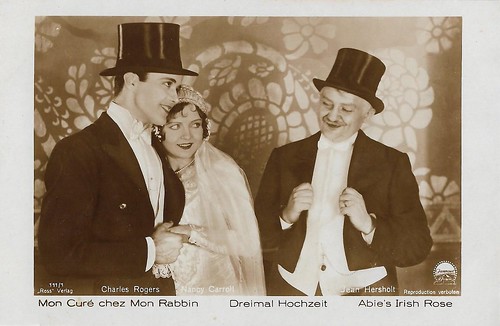
German postcard by Ross Verlag, no. 111/1. Photo: Paramount. Charles Rogers, Nancy Carroll, and Jean Hersholt in Abie's Irish Rose (Victor Fleming, 1928).

German postcard by Ross Verlag, no. 4969/1, 1929-1930. Photo: Paramount. Charles Rogers and Nancy Carroll in Illusion (1929).
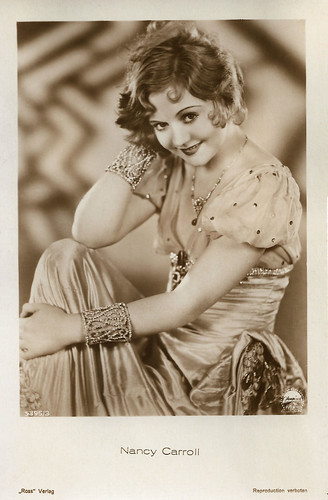
German postcard by Ross Verlag, no. 5395/3, 1930-1931. Photo: Paramount Pictures. Publicity still for Laughter (Harry d'Abbadie d'Arrast, 1930).
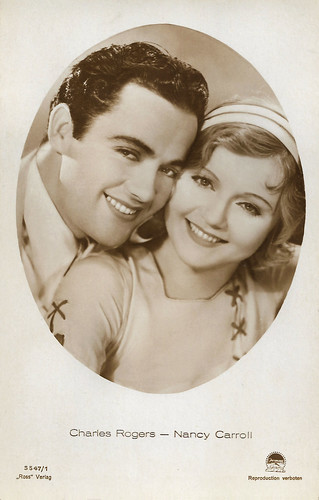
German postcard by Ross Verlag, no. 5547/1, 1930-1931. Photo: Paramount. Publicity still for Follow Thru (Lloyd Corrigan, Laurence Schwab, 1930) with Charles Rogers.
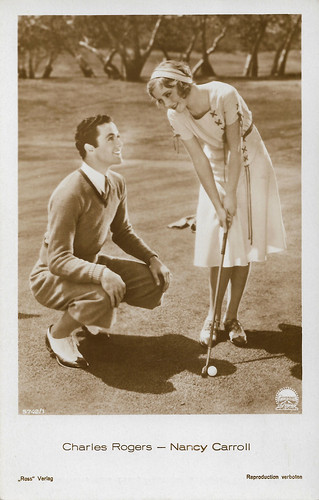
German postcard by Ross Verlag, no. 5742/1, 1930-1931. Photo: Paramount. Charles Rogers and Nancy Carroll in Follow Thru (Lloyd Corrigan, Laurence Schwab, 1930).
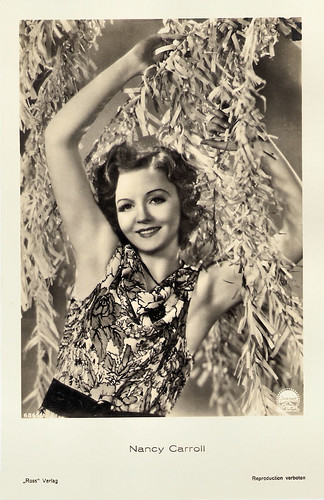
German postcard by Ross Verlag, no. 6865/1, 1931-1932. Photo: Paramount.
Paramount had a genuine superstar on their hands
In 1929, Nancy Carroll was nominated for an Academy Award for her luminous performance as savvy city girl Hallie Hobart in the highly-acclaimed The Devil's Holiday (Edmund Goulding, 1930). She didn't win but her genuine-star status was solidified. By the time Nancy filmed Honey (Wesley Ruggles, 1930), she received more fan mail than any other Hollywood star. Paramount had a genuine superstar on their hands.
Nancy Carroll continued to be a big success throughout the first half of the 1930s. Among her best films are Laughter (Harry d'Abbadie d'Arrast, 1930) with Fredric March, the all-star revue Paramount on Parade (Edmund Goulding, Dorothy Arzner, Ernst Lubitsch, a.o., 1930), and the drama Hot Saturday (William A. Seiter, 1932) with Cary Grant in his first role as a leading man and Randolph Scott.
Notable films are also The Kiss Before the Mirror (1933) directed by James Whale, and Broken Lullaby aka The Man I Killed (Ernst Lubitsch, 1932) with John Barrymore. Then her leading lady days were over.
Her last big picture was the Deanna Durbin musical That Certain Age (Edward Ludwig, 1938). She retired after its filming and returned to the stage. In the early 1950s, she tried the infant medium of television and appeared in such series as The Aldrich Family (1950-1951), and The Egg and I (1951), starring her daughter, Patricia Kirkland.
After another interval of several years, she made some other guest appearances in such TV series as Naked City (1961) and Going My Way (1963). In 1965, Nancy Carroll failed to report to a stage performance and was found dead of a heart attack. She was 61 years old. Carroll was married three times. Her husbands were Jack Kirkland (1925–1930), Francis Bolton Mallory (1931–1935) and C.H. 'Jappe' Groen (1953–1965).
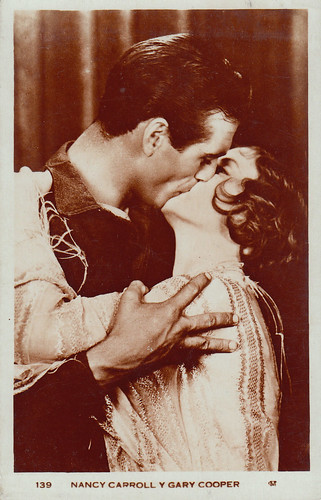
Spanish postcard by MC Barcelona, no. 139. Nancy Carroll and Gary Cooper in The Shopworn Angel (Richard Wallace, 1928). Collection: Marlene Pilaete.

Italian postcard by Cinema-Illustrazione, Milano, Series I, no. 38. Photo: Paramount.

Italian postcard by Cinema-Illustrazione, Milano, Series, I, no. 26. Photo: Paramount.
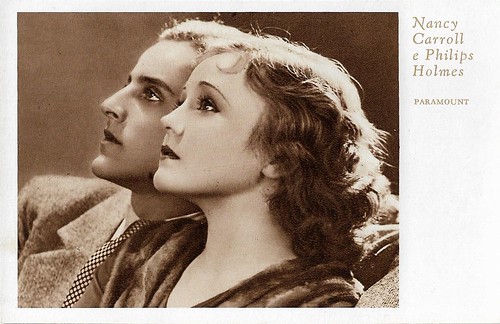
Italian postcard by Cinema Illustrazione, Milano, series II, no. 26. Photo: Paramount. Nancy Carroll and Phillips Holmes in The Devil's Holiday (Edmund Goulding, 1930).

British Real Photograph postcard in the Celebrity Series, no. 140. Photo: Paramount Pictures.
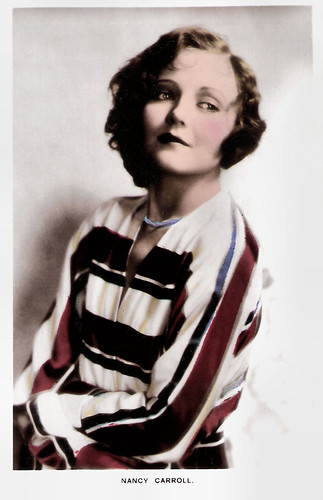
British postcard in the Colourgraph Series, London series, no. C 13.
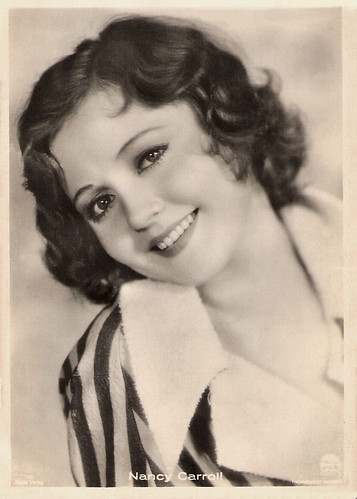
German postcard by Ross Verlag in the Luxusklasse series, no. 510. Photo: Paramount.
Sources: Denny Jackson (IMDb), Jarod Hitchings (IMDb), Wikipedia and IMDb.
This post was last updated on 9 September 2023.
No comments:
Post a Comment